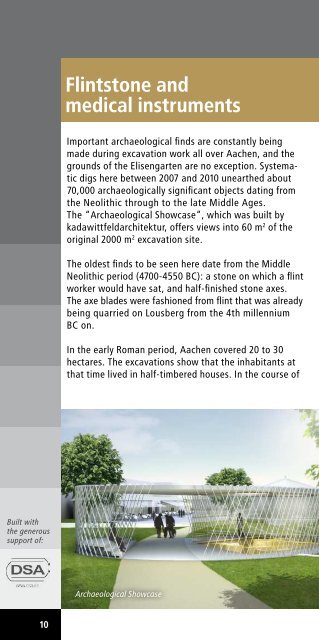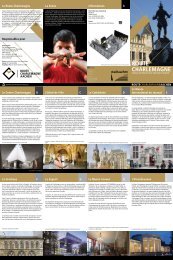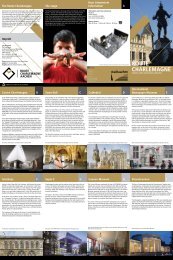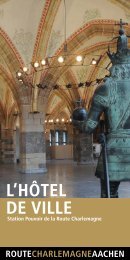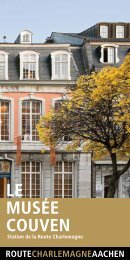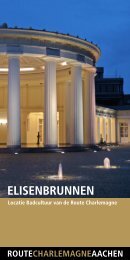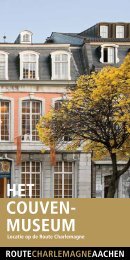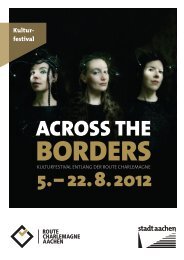Flyer - Route Charlemagne Aachen
Flyer - Route Charlemagne Aachen
Flyer - Route Charlemagne Aachen
Create successful ePaper yourself
Turn your PDF publications into a flip-book with our unique Google optimized e-Paper software.
The Archaeological Showcase<br />
Flintstone and<br />
medical instruments<br />
Important archaeological finds are constantly being<br />
made during excavation work all over <strong>Aachen</strong>, and the<br />
grounds of the Elisengarten are no exception. Systematic<br />
digs here between 2007 and 2010 unearthed about<br />
70,000 archaeologically significant objects dating from<br />
the Neolithic through to the late Middle Ages.<br />
The “Archaeological Showcase“, which was built by<br />
kadawittfeldarchitektur, offers views into 60 m 2 of the<br />
original 2000 m 2 excavation site.<br />
The oldest finds to be seen here date from the Middle<br />
Neolithic period (4700-4550 BC): a stone on which a flint<br />
worker would have sat, and half-finished stone axes.<br />
The axe blades were fashioned from flint that was already<br />
being quarried on Lousberg from the 4th millennium<br />
BC on.<br />
In the early Roman period, <strong>Aachen</strong> covered 20 to 30<br />
hectares. The excavations show that the inhabitants at<br />
that time lived in half-timbered houses. In the course of<br />
the 1st century AD, they even erected the first few stone buildings<br />
with tiled roofs and painted walls. Luxury living in Roman times<br />
included wall and underfloor heating (hypocaustum). The Archaeological<br />
Showcase features remnants of this kind of heating system<br />
from the 3rd century AD.<br />
In the 2nd and 3rd century AD, “Aquae Granni“ was a flourishing<br />
township full of craftsmen and traders, its greatest attraction being<br />
its hot springs. All around Büchel, a complex of thermal baths and<br />
temples arose. One of the buildings whose remnants archaeolo <br />
gists found in the Elisengarten was probably a hostel where spa<br />
visitors and patients would have spent time in heated rooms each<br />
meas uring 12 m 2 . Probes for the treatment of wounds and a pair of<br />
locking forceps unearthed on the site indicate that medical treatment<br />
was provided here.<br />
In the 2nd century, a small temple (aedicula) was built inside the<br />
hostel. We do not know which deity the inhabitants worshipped<br />
there. By the end of the 2nd century, the temple had fallen into<br />
disuse.<br />
Built with<br />
the generous<br />
support of:<br />
Archaeological Showcase<br />
Celtic glass armband, 3rd to 1st century BC<br />
10 <strong>Route</strong><strong>Charlemagne</strong>ELISENBRUNNEN 11


